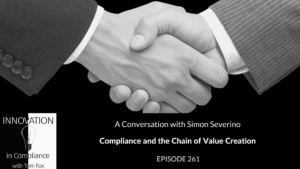
Simon Severino studied philosophy at the University of Vienna and later became a business coach at a global consultancy. Two decades of experience led him to found his own consulting firm, through which he now advises business leaders about market strategy via his Strategy SprintsTM Method. He and Tom Fox explore his signature methodology and how it translates into creating value in the compliance space.
The Problem of Strategy
Simon tells Tom that the problem was how to create strategy. There are tools to analyze the market and figure out how to enter it. However, the tools to build an organized, aligned team that gets feedback quickly were missing. Since the executive team is removed from the market, they don’t have closed loops. “For the last 15 years, I’ve been obsessed with just building that [tool],” Simon comments. “How can an executive team have an agile way of doing things so it feels like a sports team? That’s what I’ve been building. That’s now the Strategy SprintsTM Method and the Strategy SprintsTM Company and the Strategy SprintsTM product, which is 90 days coaching of executives.”
The Chain of Value Creation
“I always see the whole chain of value creation or the chain that really matters,” Simon says. The chain doesn’t stop at his clients; their clients are part of the chain as well. He says that compliance officers should consider how they can become a valuable contribution to the whole chain. He suggests that they see themselves as business partners. “Always see yourself as a business partner of your internal colleagues and… everybody serves the client out there.” Tom responds that putting the customer first translates into greater profitability. It means you become a business generator instead of a cost center, he tells Simon. They discuss Peter Drucker’s contribution to the practice of management, and how he influenced Simon’s work. “My whole work is Peter Drucker’s philosophy plus agile methods for the digital age,” Simon comments. The concept of efficiency vs effectiveness is one of Drucker’s principles he adopts: “Spend more time on effectiveness, finding out what’s the right thing to do in the first place.”
Strategy SprintsTM
Tom asks Simon to talk about the key points in his book Strategy Sprints: 12 Ways to Accelerate Growth for an Agile Business. Simon responds that it’s about asking yourself what is the right thing to do now. In today’s digital age, with broken supply chains and volatile markets, it can be difficult to make decisions. The book provides case studies and blueprints for taking the right actions in various areas like operations, marketing, sales, hiring, and client onboarding. Many CEOS today are talking about how to renegotiate contracts so that they reduce the risk of something going wrong. They can do this by splitting the risk and making sure that costs are variable instead of fixed. This will help them be more prepared if something does happen. “Risk management is the highest art form when you run a business because everything is risk/reward ratio,” Simon comments. “You have to become very good at weighted probabilities.” He explains why he thinks Elon Musk is a master of risk management, and why it’s the safer way to build a business.
Resources
Simon Severino on LinkedIn
Strategy SprintsTM | Website | Book





